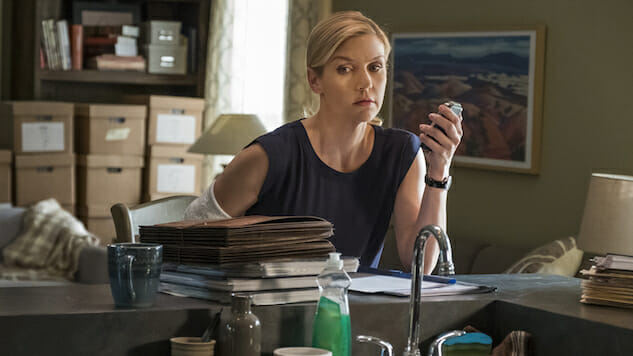Why Kim Wexler Is the Backbone of Better Call Saul
Photo: Nicole Wilder/AMC/Sony Pictures Television
If anything happens to Kim, I swear I’ll never recover.
After a decade at the white-glove law firm of Hamlin, Hamlin & McGill, after courting offers from competitors, striking out on her own, and suffering the consequences, the Albuquerque attorney has, it seems, found the perfect balance. “Piñata,” just past the midpoint of Better Call Saul’s sterling fourth season, sees Kim accept an offer to run another large firm’s banking division, hoping to secure time in her schedule for pro bono work in criminal defense. Which means, as it nearly always does in the series’ cruel universe, that the other shoe is soon to drop: In Better Call Saul, wanting to “have your cake and eat it, too,” as her boyfriend, Jimmy McGill (Bob Odenkirk), describes Kim’s new position, is the most dangerous desire of all.
Played with precision and grace by the extraordinary Rhea Seehorn—now in her fourth consecutive year giving the most underrated performance on television—Kim Wexler, with her taut blonde ponytail and sleek, simple pantsuits, has long been the object of her fans’ worst fears: In pieces published at the conclusion of Season Three and the start of Season Four, respectively, both Vanity Fair’s Rebecca Keegan and The Ringer’s Lindsay Zoldaz noted that the commonest response to Kim’s appearance on screen is worry, anxiety, dread. Increasingly, though, the character’s arc is the beating heart of Better Call Saul, as well as the series’ central mystery. No longer “the girlfriend” or “the associate”—if she ever was—Kim has emerged, over time, as a heroine on the order of Mad Men’s Peggy Olson or Halt and Catch Fire’s Donna Clark and Cameron Howe, a female foil so essential to the drama that she turns out to be its backbone. We’ve always known what happens to Jimmy—soon to be Breaking Bad’s unscrupulous Saul Goodman, and later a Cinnabon employee named Gene—and to drug kingpin Gus Fring (Giancarlo Esposito). With his death in the Season Three finale, we now know what happened to Jimmy’s brother, Chuck (Michael McKean). Kim’s fate is the series’ biggest unanswered question: She is Better Call Saul’s ace in the hole.
As if to punctuate Kim’s evolution into Jimmy’s co-protagonist, the follow-up to “Piñata,” “Something Stupid,” opens with a split-screen sequence of their diverging lives. To the strains of Frank and Nancy Sinatra’s chart-topping duet, Kim, still in her cast and sling after a brutal one-car wreck near the end of last season, unpacks boxes at her new firm, Schweikart and Cokely, and leaps into work; meanwhile, Jimmy, temporarily suspended from practicing law, whiles away the hours at a mobile phone store and orders Saul Goodman business cards, his alter ego rounding into form. It’s fitting that the best-edited series on TV—one that often outlines significant developments through the use of montage—should so close the circle on this span in Kim’s career, because it began in similar fashion. “The Post-It montage,” as I’ve since come to call it, is Better Call Saul at its finest, creating suspense, momentum, from an ordinary task performed in imperfect circumstances—in this case, Kim’s calls to potential leads as she tries to find Hamlin, Hamlin & McGill a new client. In truth, it’s two montages, one to introduce the task—dialing the numbers on multi-colored Post-It notes affixed to the glass in an HHM stairwell—and the next to complete it, the latter set, speaking of Peggy Olson, to a Spanish-language cover of “My Way.” She’s ignored, propositioned, small-talked to death, then lies to her colleagues about how she spent lunch; she’s mistaken for a secretary and spends late nights hunched over documents in the basement, where she’s being punished for upstaging her boss. And then, finally, her contact at Mesa Verde, a regional bank in the throes of a nettlesome expansion, agrees to set a meeting, culminating in a rare demonstrative moment: Kim’s crouching, double-armed, fist-pumping “Yes!” to which I cheer, on each viewing, as if it’s the Wide World of Sports. “You don’t save me,” she reminds Jimmy earlier in the episode. “I save me.”
-

-

-

-

-

-

-

-

-

-

-

-

-

-

-

-

-

-

-

-

-

-

-

-

-

-

-

-

-

-

-

-

-

-

-

-

-

-

-

-








































